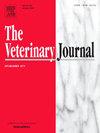Differentiating the estrous cycle phases using vaginal vestibule pH and cytology in Asian elephants (Elephas maximus) in human care
IF 3.1
2区 农林科学
Q1 VETERINARY SCIENCES
引用次数: 0
Abstract
Reproductive dysfunction in elephants is often confirmed through blood hormonal assays, as behavioral observations alone are insufficient. While fecal and saliva hormonal analyses offer welfare-friendly alternatives, significant resources are required, limiting practicality in field applications. To improve reproductive management and ensure animal welfare, this study aimed to investigate pH measurements and cytological analysis of the vaginal vestibule to differentiate estrous cycle phases in female elephants, both those with regular and irregular cycling. A total of 106 vaginal vestibule cytological smears from eight regularly cycling females and 39 smears from three irregularly cycling females (confirmed by progesterone and luteinizing hormone [LH] enzyme immunoassays, n = 308 serum samples) were analyzed using staining techniques and pH strip measurements. Based on pH, smears were categorized into acidic, neutral, and alkaline groups. Intermediate cells (ICs) varied significantly across the three groups. In regularly cycling females, ICs dominated during diestrus (67.5 %), whereas estrus was characterized by the absence of ICs and a predominance of superficial cells. ICs decreased in metestrus (36.3 %; P < 0.05). Mean pH levels ranged from acidic in diestrus (5.8) to alkaline in estrus (8.5). In irregularly cycling elephants, pH (6.3) differed from proestrus and estrus in irregularly cycling elephants. Moreover, pH was significantly correlated with progesterone (r = -0.25) and LH (r = 0.4) among all females. Using cytology exclusively was insufficient to differentiate between regular and irregular cyclic statuses; however, when combined with pH measurements, it effectively identified the estrous phases in regularly cycling elephants. This study offers novel findings that could serve as practical, welfare-focused metrics for reproductive assessments in elephants.
用阴道前庭pH值和细胞学来鉴别人类照料下亚洲象的发情周期。
大象的生殖功能障碍通常通过血液激素检测来确认,因为仅凭行为观察是不够的。虽然粪便和唾液激素分析提供了福利友好的替代方案,但需要大量资源,限制了现场应用的实用性。为了改善生殖管理和确保动物福利,本研究旨在通过对雌性大象阴道前庭的pH值测量和细胞学分析来区分月经周期规律和不规律的雌性大象的发情周期。采用染色技术和pH条测量方法,对8例正常月经女性的106份阴道前庭细胞学涂片和3例不规则月经女性的39份涂片(经黄体酮和黄体生成素[LH]酶免疫测定证实,n=308份血清样本)进行分析。根据pH值,涂片分为酸性、中性和碱性组。中间细胞(ic)在三组之间差异显著。在定期循环的雌性中,发情期间ic占主导地位(67.5%),而发情期间的特征是没有ic,以浅表细胞为主。流星期ic降低(36.3%;P < 0.05)。平均pH值从发情时的酸性(5.8)到发情时的碱性(8.5)不等。在不规律循环的大象中,pH值(6.3)不同于不规律循环的大象的发情前期和发情期。pH值与孕酮(r = -0.25)、LH (r = 0.4)显著相关。仅使用细胞学不足以区分有规律和不规则的循环状态;然而,当与pH值测量相结合时,它有效地识别了定期骑车的大象的发情阶段。这项研究提供了新的发现,可以作为实用的、以福利为中心的指标,用于大象的生殖评估。
本文章由计算机程序翻译,如有差异,请以英文原文为准。
求助全文
约1分钟内获得全文
求助全文
来源期刊

Veterinary journal
农林科学-兽医学
CiteScore
4.10
自引率
4.50%
发文量
79
审稿时长
40 days
期刊介绍:
The Veterinary Journal (established 1875) publishes worldwide contributions on all aspects of veterinary science and its related subjects. It provides regular book reviews and a short communications section. The journal regularly commissions topical reviews and commentaries on features of major importance. Research areas include infectious diseases, applied biochemistry, parasitology, endocrinology, microbiology, immunology, pathology, pharmacology, physiology, molecular biology, immunogenetics, surgery, ophthalmology, dermatology and oncology.
 求助内容:
求助内容: 应助结果提醒方式:
应助结果提醒方式:


